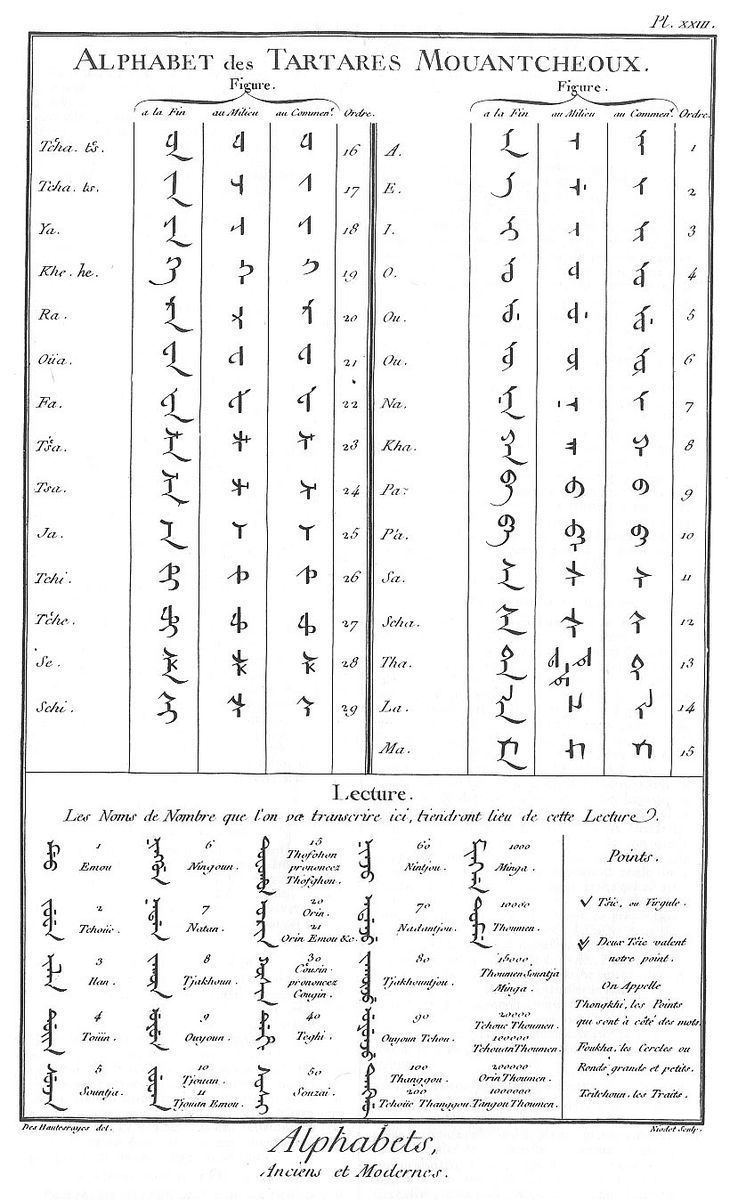 | ||
Parent systems Proto-Sinaitic alphabetPhoenician alphabetAramaic alphabetSyriac alphabetSogdian alphabetOld Uyghur alphabetMongolian scriptManchu script | ||
The Manchu alphabet is the alphabet used to write the now nearly-extinct Manchu language; a similar script is used today by the Xibe people, who speak a language variably considered as either a dialect of Manchu or a closely related, mutually intelligible, language. It is written vertically from top to bottom, with columns proceeding from left to right.
Contents
History
According to the Veritable Records (Manchu: manju-i yargiyan kooli; Chinese: 滿洲實錄; pinyin: Mǎnzhōu Shílù), in 1599 the Manchu leader Nurhaci decided to convert the Mongolian alphabet to make it suitable for the Manchu people. He decried the fact that while illiterate Han Chinese and Mongolians could understand their respective languages when read aloud, that was not the case for the Manchus, whose documents were recorded by Mongolian scribes. Overriding the objections of two advisors named Erdeni and G'ag'ai, he is credited with adapting the Mongolian script to Manchu. The resulting script was known as tongki fuka akū hergen ("script without dots and circles").
In 1632, Dahai added diacritical marks to clear up a lot of the ambiguity present in the original Mongolian script; for instance, a leading k, g, and h are distinguished by the placement of no diacritical mark, a dot, and a circle respectively. This revision created the Standard script, known as tongki fuka sindaha hergen ("script with dots and circles"). As a result, the Manchu alphabet contains little ambiguity. Recently discovered manuscripts from the 1620s make clear, however, that the addition of dots and circles to Manchu script began before their supposed introduction by Dahai.
Dahai also added ten graphemes (tulergi hergen: "foreign (outer) letters"), to allow Manchu to be used to write Chinese, Sanskrit, and Tibetan loanwords. Previously, these words contained sounds that did not have corresponding letters in Manchu. Sounds that were transliterated included the aspirated sounds k' (Chinese pinyin: k, ᠺ), k (g, ᡬ), x (h, ᡭ); ts' (c, ᡮ); ts (ci, ᡮ᠊ᡟ); sy (si, ᠰ᠊ᡟ); dz (z, ᡯ); c'y (chi, ᡱᡟ); j'y (zhi, ᡷᡟ); and ž (r, ᡰ).
By the middle of the nineteenth century, there were three styles of writing Manchu in use: standard script (ginggulere hergen), semi-cursive script (gidara hergen), and cursive script (lasihire hergen). Semicursive script had less spacing between the letters, and cursive script had rounded tails.
The Manchu alphabet was also used to write Chinese. Manchu: a textbook for reading documents, by Gertraude Roth Li, contains a list comparing a romanization of Chinese syllables written in Manchu compared to pinyin and Wade Giles. Using the Manchu script to transliterate Chinese words is a source of loanwords for the Xibe language. Several Chinese-Manchu dictionaries contain Chinese characters transliterated with Manchu script and the Manchu version of the Thousand Character Classic is actually the Manchu transcription of all the Chinese characters. Also existing as a transliteration was the Manchu version of the Hong Loumeng (紅樓夢).
In the "Imperial Liao-Jin-Yuan Three Histories National Language Explanation" (欽定遼金元三史國語解 Qinding Liao Jin Yuan sanshi guoyujie) commissioned by the Qianlong Emperor, the Manchu alphabet is used to write Evenki (Solon) words. In the Pentaglot Dictionary, also commissioned by the Qianlong Emperor, the Manchu alphabet is used to transcribe Tibetan and Chagatai (Modern Uyghur) words.
Method of teaching
Despite the alphabetic nature of its script, Manchu was traditionally taught as a syllabary. Like the Mongols, Manchu children were taught to memorize all the syllables in the Manchu language separately as they learned to write, dividing the syllables into twelve different classes, based on the final phonemes of the syllables, all of which ended in vowels. When learning the language, Manchus were taught at once to say la, lo, etc., instead of saying I, a---la; I, o---lo; etc. As a result, the syllables contained in their syllabary do not contain all possible combinations that can be formed with their letters. They made, for instance, no such use of the consonants I, m, n, and r, as westerners do when they called them liquid; hence if the Manchu letters s, m, a, r, t, were joined in that order, a Manchu would not pronounce them as English-speaking people pronounce the word smart.
Today, the opinion on whether it is alphabet or syllabic in nature is still split between different experts. In China, it is considered syllabic and Manchu is still taught in this manner, while in the West it is treated like an alphabet. The alphabetic approach is used mainly by foreigners who want to learn the language, as studying the Manchu script as a syllabary takes a longer time.
Punctuation
The Manchu alphabet has two kinds of punctuation: two dots (᠉), analogous to a period; and one dot (᠈), analogous to a comma. However, with the exception of lists of nouns being reliably punctuated by single dots, punctuation in Manchu is inconsistent, and therefore not of much use as an aid to readability.
The equivalent of the question mark in Manchu script consists of some special particles, written at the end of the question.
Jurchen script
The Jurchens of a millennium ago became the ancestors of the Manchus when Nurhaci united the Jianzhou Jurchens (1593–1618) and his son subsequently renamed the consolidated tribes as the "Manchu". Throughout this period, the Jurchen language evolved into what we know as the Manchu language. Its script has no relation to the Manchu alphabet, however, as their script was derived from the Khitan script, which was in turn derived from Chinese characters.
